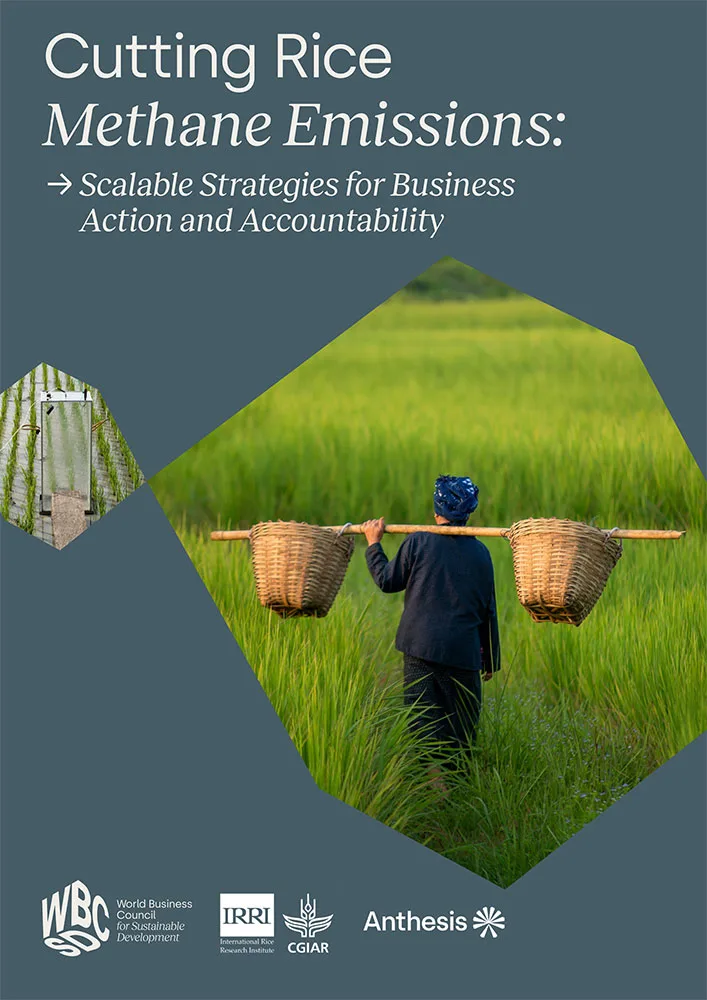New Business Guidance equips companies to cut rice methane emissions
Actionable strategies to scale low-emission, sustainable rice value chains
Published: October 31, 2025

Geneva, 31 October 2025 – Today, the World Business Council for Sustainable Development (WBCSD) launches new guidance titled ‘Cutting Rice Methane Emissions: Scalable Strategies for Business Action and Accountability. Developed in collaboration with the International Rice Research Institute, Anthesis Group, Ceres, and additional partners and members – with the support of the Global Methane Hub – this guidance is part of WBCSD’s Rice Methane Action Alliance (RMA). It provides practical strategies for companies to cut methane emissions from rice cultivation, aligned with the core outcomes and indicators for regenerative agriculture, which WBCSD led global business alignment on.
Rice Methane Emissions – An Urgent Climate Priority
Rice feeds more than half the global population, yet flooded rice fields are among the largest agricultural sources of methane, a greenhouse gas with 84 times the global warming potential of CO₂ over 20 years (IPCC AR6, 2023). Methane emissions from rice cultivation account for roughly 12% of global methane releases, primarily due to anaerobic decomposition of organic matter in flooded paddies. These emissions are influenced by several factors including water management practices, organic inputs, soil properties, climate, and rice varieties.
Methane is a highly potent greenhouse gas with a relatively short atmospheric lifespan of about nine years. This makes reducing methane emissions from rice-producing landscapes one of the most immediate and cost-effective opportunities for climate mitigation. Targeted action in this area can deliver rapid results while complementing longer-term strategies to reduce other greenhouse gases.
The need for swift action is reinforced by corporate climate frameworks such as the Science Based Targets initiative (SBTi). Under its Forest, Land and Agriculture (FLAG) Sector Guidance, rice follows a commodity-specific pathway requiring an absolute annual emissions reduction of 2.9%. Meeting these targets is critical for aligning corporate climate strategies with global climate commitments.
Rice Methane Action Alliance (RMA) – Mobilizing Private Sector Leadership
To address the challenges and opportunities in reducing rice methane emissions, WBCSD established the Rice Methane Action Alliance (RMA) with support from the Global Methane Hub. The Alliance brings together companies and partners across the rice value chain to share best practices and collectively develop practical guidance. Its goal is to align corporate climate targets with field-level solutions that cut rice methane emissions, while improving farmer livelihoods, advancing sustainable value chains, and delivering positive environmental outcomes.
Scalable Methane Mitigation in Rice Value Chains
Reducing methane emissions in rice production requires more than ambition—it calls for science-based, practical guidance that reflects the complexity of rice production systems and aligns with established standards.
Effective Measurement, Reporting, and Verification (MRV) approaches are essential to track progress and impact, ensure credibility, and unlock climate finance. Yet many actors across the rice value chain face challenges applying existing frameworks for corporate disclosure and operational decisions because methodologies are complex and often disconnected across rice value chains.
This guidance brings clarity by consolidating key elements from leading frameworks. It aligns with global standards such as the GHG Protocol and SBTi FLAG, while integrating rice-specific methodologies from Verra, Gold Standard, and the Sustainable Rice Platform.
It offers practical approaches to help companies measure emissions, set reduction targets, and implement locally tailored mitigation strategies and MRV systems. To promote transparency and credibility, it also provides clear steps for developing a Rice Action Plan (RAP) that can be adapted to different regions and company roles within the value chain. The approach centers on three essential steps: Disclosure, Planning, and Progress Tracking, with practical checklists detailed for each step.
Join the Rice Methane Action Alliance to Turn Commitments into Action
The Rice Methane Action Alliance (RMA) is bringing together companies and partners across the rice value chain to accelerate the adoption of low-emission, sustainable rice production systems worldwide.
By using this guidance, member companies can identify key methane emission hotspots in their supply chains and unlock opportunities for coordinated action through collaborations across rice value chains facilitated by the Alliance. This is where ambition turns into implementation: businesses can develop comprehensive Rice Action Plans (RAPs) aligned with the provided guidelines.
Building on this foundation, companies can design mitigation strategies tailored to local contexts and rice cultivation systems, while engaging farmers, suppliers, and input providers to scale proven practices and technologies. These efforts not only reduce emissions but also advance sustainable rice production and deliver shared value across rice value chains.
By joining the alliance, companies can drive coordinated action on rice methane emission reductions. We call on rice value chain players to join our efforts today — become part of a frontrunner group cutting rice methane emissions and delivering competitive, low-emissions, and sustainable rice value chains.
– Stefania Avanzini, Agriculture & Food Director
For information on how to join the RMA contact aiama@wbcsd.org.